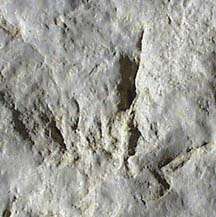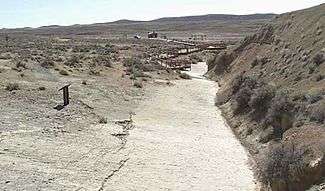Red Gulch Dinosaur Tracksite
.jpg)

Red Gulch Dinosaur Tracksite is an assemblage of fossil dinosaur footprints on public land near Shell, in Big Horn County, Wyoming.[1]
They were discovered in 1997 by Erik P. Kvale, a research geologist from the Indiana Geological Survey.[2]
The site is managed by the Bureau of Land Management as part of the Red Gulch/Alkali National Back Country Byway and is open to the public.[1]
Fossils
The fossilized tracks are believed to have been made during the Middle Jurassic Period, 160-180 million years b.p., on what was then a shore of the Sundance Sea.[3] Theropod tracks are thought to be among those discovered, but evidence suggests that the tracks were made by a large, diverse group of dinosaurs.[4][5]

Geology
The tracksite is in a limestone layer in the lower part of the Sundance Formation. Its discovery was somewhat surprising, since the Sundance was historically considered to be marine in nature. Indeed, the layer just above the tracksite contains abundant marine fossils including numerous Gryphaea nebrascensis, indicating that later in the Jurassic it was once again submerged.[4]
References
- 1 2 BLM: Red Gulch Dinosaur Tracksite
- ↑ Indiana.edu: Erik P. Kvale
- ↑ N.H. Darton, Jurassic formations of the Black Hills of South Dakota, Geological Society of America Bulletin, v.10, p. 383-396 (1899).
- 1 2 Emory.edu: Red Gulch Dinosaur Tracksite; by Chamberlain, C. Kent.
- ↑ Nature.nps.gov: B. Breithaupt et al., Innovative documentation methodologies in the study of the most extensive dinosaur tracksite in Wyoming
External links
- BLM Wyoming.gov: official Red Gulch Dinosaur Tracksite website
- Geo-sciences.com: Red Gulch Dinosaur Tracksite – Wyoming’s Middle Jurassic Treasure
- State University of New York at Stony Brook.edu: Red Gulch Dinosaur Tracksite photo gallery
| Wikimedia Commons has media related to Red Gulch Dinosaur Tracksite. |
Coordinates: 44°29′10″N 107°47′15″W / 44.48620°N 107.78748°W
| Jurassic Period | ||
|---|---|---|
| Lower/Early Jurassic | Middle Jurassic | Upper/Late Jurassic |
| Hettangian | Sinemurian Pliensbachian | Toarcian |
Aalenian | Bajocian Bathonian | Callovian |
Oxfordian | Kimmeridgian Tithonian |